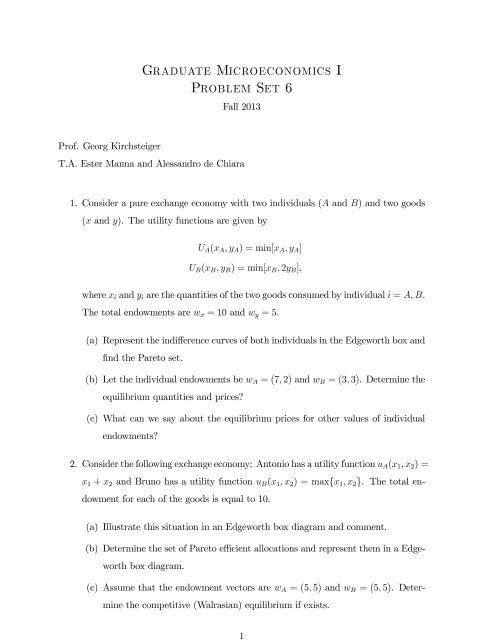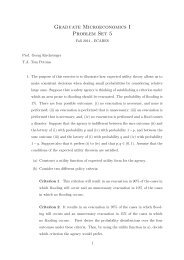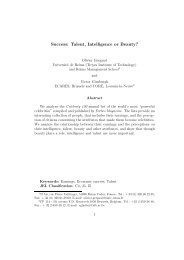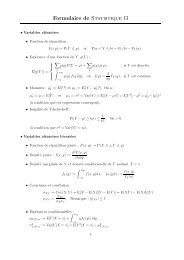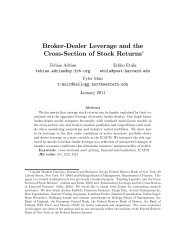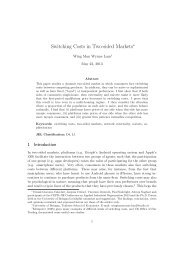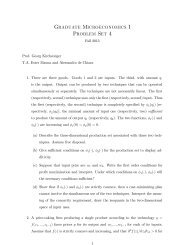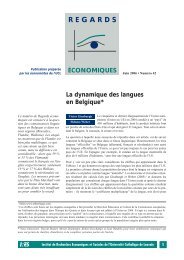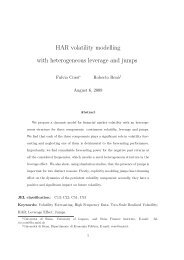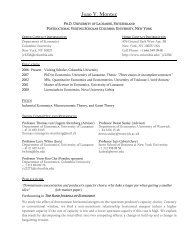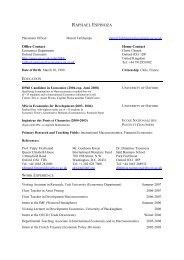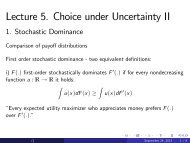Graduate Microeconomics I Problem Set 6 - Ecares
Graduate Microeconomics I Problem Set 6 - Ecares
Graduate Microeconomics I Problem Set 6 - Ecares
You also want an ePaper? Increase the reach of your titles
YUMPU automatically turns print PDFs into web optimized ePapers that Google loves.
1<br />
<strong>Graduate</strong> <strong>Microeconomics</strong> I<br />
<strong>Problem</strong> <strong>Set</strong> 6<br />
Fall 2013<br />
Prof. Georg Kirchsteiger<br />
T.A. Ester Manna and Alessandro de Chiara<br />
1. Consider a pure exchange economy with two individuals (A and B) and two goods<br />
(x and y). The utility functions are given by<br />
U A (x A ,y A )=min[x A ,y A ]<br />
U B (x B ,y B )=min[x B , 2y B ],<br />
where x i and y i are the quantities of the two goods consumed by individual i = A, B.<br />
The total endowments are w x =10and w y =5.<br />
(a) Represent the indifference curves of both individuals in the Edgeworth box and<br />
find the Pareto set.<br />
(b) Let the individual endowments be w A =(7, 2) and w B =(3, 3). Determinethe<br />
equilibrium quantities and prices<br />
(c) What can we say about the equilibrium prices for other values of individual<br />
endowments<br />
2. Consider the following exchange economy: Antonio has a utility function u A (x 1 ,x 2 )=<br />
x 1 + x 2 and Bruno has a utility function u B (x 1 ,x 2 )=max{x 1 ,x 2 }. The total endowmentforeachofthegoodsisequalto10.<br />
(a) Illustrate this situation in an Edgeworth box diagram and comment.<br />
(b) Determine the set of Pareto efficient allocations and represent them in a Edgeworth<br />
box diagram.<br />
(c) Assume that the endowment vectors are w A =(5, 5) and w B =(5, 5). Determine<br />
the competitive (Walrasian) equilibrium if exists.
2<br />
(d) Assume that the endowment vectors are w A =(4, 1) and w B =(6, 9). Determine<br />
the competitive (Walrasian) equilibrium if exists.<br />
3. There are two individuals who derive utility from food (x) and leisure (l). The<br />
utility functions are U 1 (x 1 ,l 1 )=x 1/2<br />
1 l 1/2<br />
1 and U 2 (x 2 ,l 2 )=x 3/4<br />
2 l 1/4<br />
2 . Each individual<br />
is endowed with five hours of time, which they can use for leisure or labor supply (for<br />
which they receive a competitive wage). The food can be produced from labor by<br />
the single firm which uses the following technology: x =2 √ L,whereL is aggregate<br />
labor with L =10− l 1 − l 2 . The firm is jointly owned by the individuals and the<br />
profits are shared equally between them.<br />
(a) Write the consumers’ and producer’s problems for this economy. Explain why<br />
we can normalize one of the prices.<br />
(b) Find the competitive equilibrium: quantities and prices.<br />
(c) Is this equilibrium is Pareto efficient<br />
(d) Assume that the government controls the labor market and imposes a minimal<br />
nominal wage which is higher than the equilibrium wage. How is this going to<br />
affect the welfare of the individuals Explain.<br />
4. Suppose there are perfectly competitive markets with only two individuals, Philippe<br />
and Irina, and two goods, twinkies (T ) and guitar playing time (G). Irina likes the<br />
way Philippe plays and enjoys it when Philippe plays the guitar. However, as with<br />
our usual assumptions under perfect competition, Irina is unable to set the price of<br />
guitars and takes Philippe’s quantity of guitar playing as fixed. Philippe has a utility<br />
function U P (T P ,G P )=T P G P and Irina has a utility function U I (T I ,G I ,G P )=<br />
T I G I +10G P . They are endowed with two twinkies each and two hours of guitar<br />
playing time each.<br />
(a) Find the competitive prices and allocation.<br />
(b) Is this a Pareto optimal allocation [Hint: try having Irina give Philippe 1/10<br />
of an hour of guitar playing time.]<br />
(c) If U I (T I ,G I ,G P )=T I G I , what are the Pareto optimal allocations
3<br />
5. Consider a pure exchange economy with two consumers, and two goods. The indirect<br />
utility functions of the agents are given by:<br />
v 1 (p 1 ,p 2 ,w 1 )=lnw 1 − a ln p 1 − (1 − a)lnp 2<br />
v 2 (p 1 ,p 2 ,w 2 )=lnw 2 − b ln p 1 − (1 − b)lnp 2 ,<br />
with 0
4<br />
7. Consider an economy with two goods: labor and a heating fuel. Good two (heating<br />
fuel) is produced either from a constant-returns technology (coal mine) given by<br />
y 1 = z 1 y 1 ≥ 0, z 1 ≥ 0, or from a decreasing returns technology (chopping down<br />
trees) given by y 2 =2 √ z 2 , y 2 ≥ 0, z 2 ≥ 0. y j is the quantity produced by firm<br />
j =1, 2; z j is the quantity of labor used by firm j. The economy consists of two<br />
consumers whose consumption sets are given by :<br />
X 1 = {(l i ,x i )|x i ≥ 0, 0 ≤ l i ≤ 3} i =1, 2<br />
where l i is the quantity of labor offered by consumer i, andx i is the quantity of fuel<br />
consumed by consumer i. The preferences of consumer i are given by<br />
U i (l i ,x i )= 1 2 ln(3 − l i)+ 1 2 ln x i i =1, 2<br />
(a) Characterize the feasible outcomes (allocations) in this economy.<br />
(b) Define the Pareto optimal allocations for this economy (just state the problem<br />
at this stage; you will be asked to solve it below).<br />
(c) Determine the aggregate production function of the economy. That is, find the<br />
best way to allocate a fixed amount of input ¯z between the 2 technologies in<br />
order to maximize the total production, y 1 + y 2 .<br />
(d) Determine the set of Pareto optimal allocations. Show that all the Pareto<br />
optima are achieved from the same production plan.<br />
(e) Now, suppose that the production sector is nationalized. The planner creates a<br />
conglomerate called “The Company of Fuels”, which integrates the two firms.<br />
The conglomerate must choose its production plan to minimize its total cost<br />
for any given level of output (normalize the price of labor at one). It must<br />
price at average cost, and satisfy all the demand forthcoming at this price.<br />
Each consumer is free to sell his labor on the labor market and to buy fuel<br />
at its market price p. Characterize the resulting equilibrium. Is this solution<br />
optimal<br />
(f) Now the planner requires the conglomerate to price at marginal cost and to<br />
transfer a fraction α i ∈ [0, 1], (α 1 + α 2 =1)of profits to consumer i. Characterize<br />
the equilibrium and show that when α 1 varies (from 0 to 1) the cor-
5<br />
responding equilibria make up a strict subset of the set of Pareto optima. In<br />
what sense can we talk about competitive equilibrium<br />
Additionally, students are also encouraged to do the following exercises:<br />
1. MWG 10.B.2<br />
2. MWG 10.C.2<br />
3. MWG 10.C.8<br />
4. MWG 10.C.9<br />
5. MWG 16.C.1<br />
6. MWG 16.C.4<br />
7. MWG 16.D.2<br />
8. MWG 16.E.2<br />
9. MWG 16.G.3<br />
10. MWG 17.B.3<br />
11. MWG 17.B.4<br />
12. MWG 17.C.6<br />
13. MWG 18.B.5


